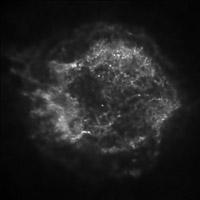Generation of elements

Images of the Cassiopeia-A nebula, sent by the Chandra space telescope, can help you discover where and how the chemical elements form. The stars burn hydrogen and helium, the simplest chemical elements, and as a result of this burning and explosion of supernovae, silicon, oxygen and other heavier elements are created.
Cassiopiea-A, for example, is the result of a supernova explosion of these features, with areas very rich in silicon, iron and sulfur. The brilliant sets of silicon and sulfur, apparently, were formed at 3,000 million °C at the time of the star explosion.
The areas rich in the irons were formed to greater depths than the previous ones, in a hell of between 4 and 5.000 million °C. The latter, however, have moved faster and are now found outside the nebula. Understanding the explosions of supernovae can help us to know our planet, since the elements resulting from the explosion allow to create other elements and their combinations create planets.






